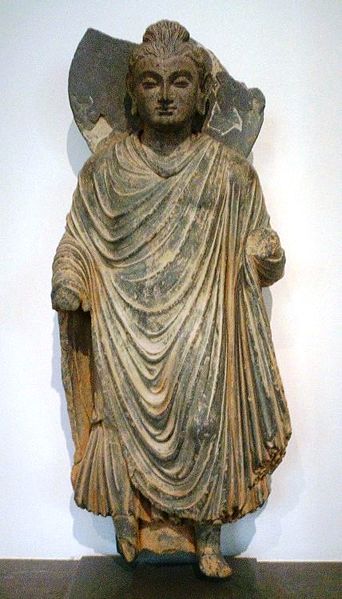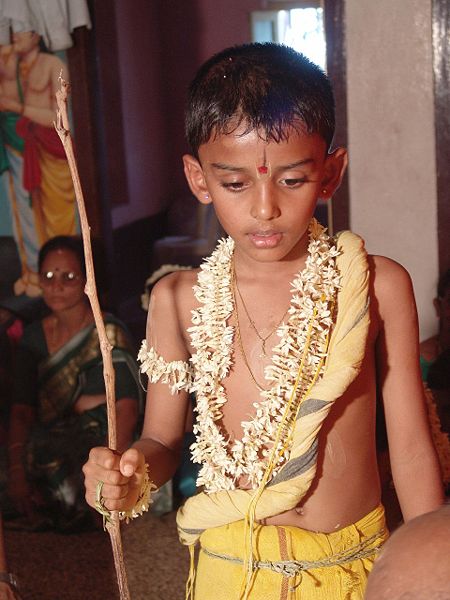
Karma Yoga
Path of Action
|
|
| Siddhartha Guatama or the Buddha was born into the Hindu kshatriya caste |
Karma Yoga The way through duty, work and action. Reflected in the first third of the Bhagavad-Gita, chapters 1 - 6. If you stopped someone today and asked which yoga he or she followed, the response would likely be either Karma Yoga or Bhakti Yoga. As a follower of Bhakti or Jnana Yoga, you would also likely practice Karma Yoga as you approach your work attempting to diminish self-centeredness, diminish the ego, that which separates you from God. On your journey to Moksha you bring Karma Yoga into all aspects of your life.
Mahatma Gandhi encapsulated this yoga in the phrase, nishkama karma - "selfless action." Remember that kama, when left unchecked, refers to selfish desires, and such cravings ultimately render people alienated from others and Divinity, absorbed in their attachments.
Karma Yoga generally involves consideration of three key components, also reflected in Krishna's arguments for Arjuna to go to war:
1. - be true to your dharma, given your social and spiritual dharma stations in your age and caste, and cycle of reincarnations, including:
A. caste-based social dharma
WR: what are the arguments for maintaining a caste structure?
- brahmin - seers, priests and scholars (the head)
- kshatriya - administrators, rulers and warriors (the shoulders and arms) - Arjuna in Gita 2:31-37
- vaishya - producers, craftsmen and merchants (the torso and vital organs)
- shudra - workers, laborers and peasants (the legs and mobility)B. life-cycle, age-based dharma, and some associated rites of passage:
a. CHILDHOOD
- ceremony at conception
- hair-braiding ceremony of the expectant mother
- baby-naming ceremony (mamakarana)
- weaning ceremony (anaprasana)b. STUDENT
- initiation of the "twice-born" (three upper castes) and the "Sacred Thread Ceremony" (upanayana)

A young Brahmin boy doing his Upanayana c. HOUSEHOLD and FAMILY PROVIDER - Stage of Selflessness
- marriage (vavaha)d. RETIREMENT - Stage of Renunciation
e. DEATH and REBIRTH - Seek Moksha
- funeral (sraddha)C. samsara-based spiritual dharma (Gita 2:19-25)
Example: "Scorpion and Sage Story"
Example: "Tiger Story" (about realizing your dharma and seeking Moksha) - we are all tigers living among goats; find your tiger guru and true reflection in the pond, and awaken your tiger!
2. - act with utmost skill and effort, and with pure, noble intentions
do everything to the best of your ability
do nothing that is ethically inappropriate
but you must act
3. - act, renouncing the fruits of one's actions - Arjuna in Gita 2:47-50 and 4:15-23
RW: Meaning? Example in your experience? Example of focus on fruits?
What are the considerations of doing so?
Can you ultimately control the outcome of your actions?
Don't we only have control over your performance, being true to your dharma, with pure and ethical intentions, acting to the best of your ability?
When you focus your actions on success or failure, praise or blame, victory or defeat, "bowl eligibility," on these sorts of consequences, how does that effect your performance?
Is not your best effort and performance compromised, with unruffled mind and body, when we focus on the consequences?
"its not whether you win or lose, its how you play the game."
When we focus on the outcomes, are we not enslaving ourselves to attachments (e.g., material things) and selfish ego-enhancement (e.g., social markers of success), that can come with successful outcomes? Does that not also distracted us from our best efforts by enslaving us to our "toys"?
By renouncing the fruits of actions you are not freed from the bondage of attachments?
"you can't take it with you," "the winner is not the one who has the most toys"
One consequence: the greatest works are those in which you give and do so anonymously! Consider the greatest of Hero's, where action becomes invisible action, as if, inaction.
Is not selflessly action going to eventually lead us to obtain Liberation - Moksha?
Note: renunciation does not mean indifference to the results of one's actions - must be aware of consequences after-the-fact. Need feedback and do not want to be indifferent to actions that are morally and ethically wrong.
Gandhi was once asked to summarize his life in 25 words or less. He offered three: "Renounce and enjoy"